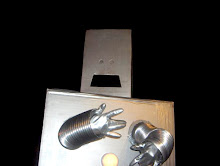 Be warned, the boundaries between work and pleasure can blur for freelancers. What begins as a laziness in the pre-frontal lobe quickly spreads to the extremities. Pretty soon you're calling soap operas "your stories" and your brain has become damaged.
Be warned, the boundaries between work and pleasure can blur for freelancers. What begins as a laziness in the pre-frontal lobe quickly spreads to the extremities. Pretty soon you're calling soap operas "your stories" and your brain has become damaged.
Freelancing is great, but there are whole categories of basic, fundamental life functions that need to be explained to you like a baby needs spoon-feeding. Here comes the airplane. First things first, the brain is an idiot. How many incredible and noteworthy thoughts have come and gone because I mistakenly thought I would remember them later? How many times have I wandered grocery stores or worse, just driven right past it like I'm suffering from dimensia? I probably know the answer and can't remember. Memory can't be trusted. If you need to remember something, write it down.
The brain is unorganized. As I said in a previous post, the simplest organizational trick in the world is to make a physical list of everything you need to get done. Seeing it makes it real. Every time you cross an item off that list, it psychologically energizes you and gives you the energy to tackle the next task. Try it, I think you'll agree.
Once you have your ability to remember things, give it something to remember. Try setting a routine or schedule. Mondays are client feedback. Wednesdays are all about acounting and invoices. Fridays are new business development days. Sounds boring, but you did it back in the real world, and it's a soundtrack for discipline. AND it's the one thing that helps you keep your work week from flowing into and devouring your weekend unnecessarily.
The brain is fickle. In the real world, everyone is shoehorned into a remorseless nine to five existence. But in the magical land of freelance and rainbows, I've found my best hours are around five or six in the morning, and I generally come unglued around three in the afternoon. Learn your rythym.
IM, MSN, Facebook and Twitter are all time vampires. Drop your guard for a second and the internet will destroy both lobes of your brain, so keep it in check. Give yourself line breaks, set a time, and stick to it. Don't get caught up no matter how interesting the outside world might seem. Resist temptation.
What do I do? I do my best to do everything I've mentioned. I also take showers, and I work in clothes instead of pyjamas. I only work in my office. I use boring dignity to keep my head up, even though the cool thing is I don't have to. There will be more posts along this thread. I hope you'll save room. Nom nom nom.
[author note: if you google image search brain damage, you'll find Amy Winehouse on every page]
 Creating peripheral promotional offerings to help boost your new brand or product isn't easy, but it's cool. It's really cool. Toyota is unleashing their newest microcar, a tiny little number called the "iQ". This tiny torpedo seats four and eats up a mere 118 inches of roadspace, which is easy when everyone is sitting on everyone else's lap. What? Oh, it apparently actually does have four seats. Oh. In the video we only really see two designers and a racecar driver slash honoury designer perform the clown car trick, so you will have to forgive me.
Creating peripheral promotional offerings to help boost your new brand or product isn't easy, but it's cool. It's really cool. Toyota is unleashing their newest microcar, a tiny little number called the "iQ". This tiny torpedo seats four and eats up a mere 118 inches of roadspace, which is easy when everyone is sitting on everyone else's lap. What? Oh, it apparently actually does have four seats. Oh. In the video we only really see two designers and a racecar driver slash honoury designer perform the clown car trick, so you will have to forgive me.













































